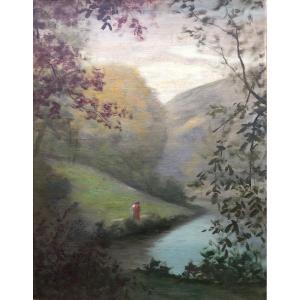Maurice Chabas is a painter who has an extra touch of soul; his mysticism has made him create a work of great professional purity and high spirituality. The Mercure de France said at the time about him that he painted "large landscapes whose harmonious calm blossoms like the most serene music of summer, landscapes so calm that the impression is religious." Comment that goes particularly well with this painting.
Maurice Chabas (1862-1947) was born in Nantes. Son of a rich merchant who loved painting, he is the older brother of the painter Paul-Émile Chabas. After following courses at the School of Fine Arts in Nantes, he continued with teaching at the Julian Academy where he was a student of William Bougereau and Tony Robert-Fleury. After devoting himself to gallant pre-Raphaelitism in the 1890s, he gradually turned to symbolist landscapes. It is this second phase which ensures Maurice Chabas a number of purchases by the State. By rejecting realism, Chabas proposed a complete reform of the art of painting which he transmitted with eloquence and conviction in his writings: “For a long time, alas! the artist confined himself in the sensations and impressions of the outside world. He was an eye and a hand but neglected the manifestations of the interior life, which alone would give a definitive character to these works.” Art is all personal, all intimate and reflexive at Chabas. These works are imbued with mysticism. For him “art must elevate the soul of the spectator, and magnetize it towards the realities of higher worlds. » It is perhaps the journalist and art critic Léon de Saint-Valéry who best described this dimension of Maurice Chabas' painting: “From all these landscapes emanate serenity, peace, like a supreme detachment. Things seem to have lost their materiality. Their beauty tends to the desire for absolute beauty, that which will be both harmonic and geometric; their appeasement predisposes to the mental silence necessary to perceive the word hidden beneath appearances”














![[hst] Mangenot (emile) - Oil On Canvas, Signed: Plain Landscape.](https://www.proantic.com/galerie/galerie-babel/img/small/703803-main-5feae2c7a9b79.jpg)








 Le Magazine de PROANTIC
Le Magazine de PROANTIC TRÉSORS Magazine
TRÉSORS Magazine Rivista Artiquariato
Rivista Artiquariato
